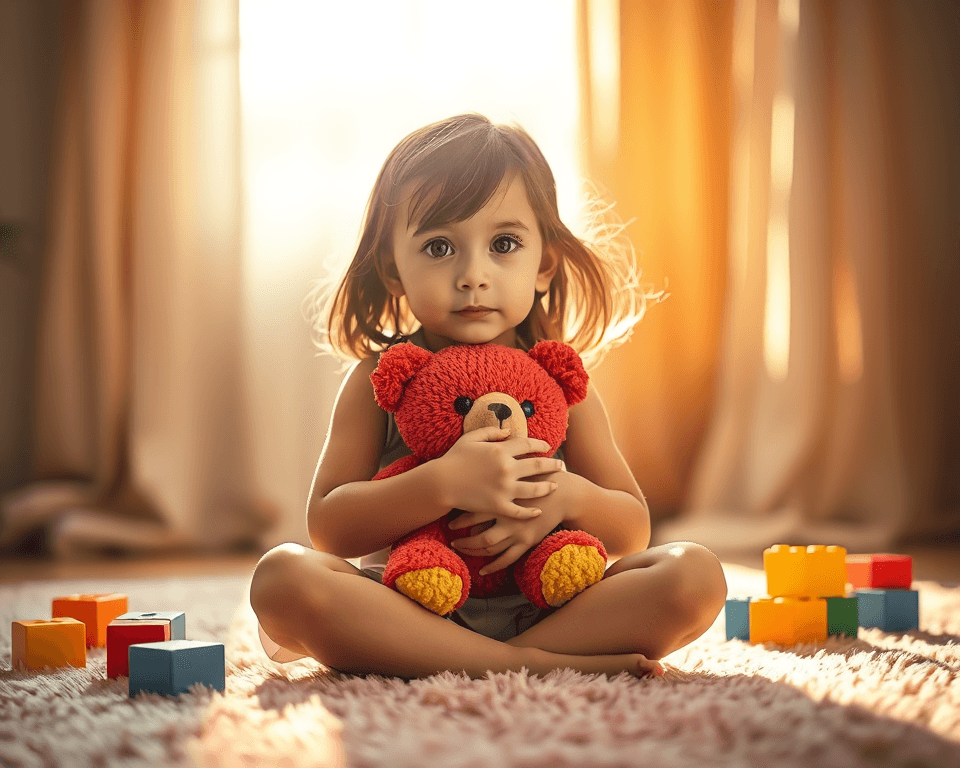As a parent, I know firsthand how crucial it is to help our kids develop solid emotional skills. Watching them navigate friendships, face disappointments, and manage those big feelings can feel overwhelming at times. But imagine if you could arm your little ones with the tools they need to understand and regulate their emotions? Sounds pretty powerful, right?
You see, fostering emotional self-regulation isn’t just about making your life easier—it’s about giving your child a head start in life. I’ve discovered some engaging, easy-to-implement activities that can make this process a breeze. These activities not only keep kids entertained but also help them channel their emotions in healthy ways. Trust me, you’re gonna want to try these out!
Key Takeaways
- Mindfulness techniques can enhance emotional awareness, leading to better decision-making and stress management.
- Creative expression through art assists in processing emotions, offering a healthy outlet for feelings.
- Role-playing develops empathy and social understanding, teaching kids how to navigate tricky emotional landscapes.
- Physical activities are not just fun; they’re also essential for emotional well-being, providing kids with an energetic release and improving their mood.
- Storytime isn’t just for bedtime; it’s a powerful tool for discussing feelings and fostering emotional literacy.
Mindfulness Practices
Let’s kick things off with something I absolutely love: mindfulness. This isn’t just a trendy buzzword; it’s an effective way for kids to learn how to tune into their feelings. Introducing mindfulness practices into your child’s routine can help them build emotional awareness and stability, giving them the ability to recognize their emotions before they spiral out of control.
Benefits of Mindfulness for Emotional Self-Regulation
Think of mindfulness as a superpower for your kid’s brain. It helps them manage stress, boosts emotional intelligence, and improves focus. Research shows that mindfulness practices can enhance self-regulation and emotional management, which can literally change the game for them. I mean, who wouldn’t want their kid to be more emotionally stable, right?
“Mindfulness isn’t just a practice; it’s a lifestyle that can help children build resilience and emotional strength.”
Simple Mindfulness Activities for Kids
Alright, let’s get into some simple mindfulness activities! These can easily be integrated into your daily routine—and best of all, they don’t require fancy materials.
Breathing Exercises: Have your child sit comfortably and take deep breaths. Encourage them to count to four while inhaling, hold for four, and exhale for six. This simple technique can calm any stormy emotional sea.
Nature Walks: Taking a stroll outside? Perfect! Ask your child to notice the colors, sounds, and smells around them. This brings them back to the present, allowing them to engage their senses fully.
Mindfulness Games: Play games like “I Spy” that focus on observation and appreciation of surroundings. Turn it into a fun competition to keep them engaged.
The beauty of these activities is that they cater to kids of various ages—whether they’re in preschool or middle school, they’ll benefit from practicing mindfulness.
Creative Expression Through Art
Now, let’s talk art! When was the last time you saw your child pick up a crayon and start creating? That’s not just doodling, my friend; it’s emotional expression at its finest. Creativity isn’t just for artists; it can be a powerful tool for kids to explore their feelings.
How Art Enhances Emotional Regulation
Art allows children to express emotions that might be difficult to articulate. It can be profoundly therapeutic and helps in emotional processing. When kids engage in creative activities, they’re learning to connect feelings with actions, which is a vital skill for self-regulation.
Here’s the kicker: Studies show that creative activities can also enhance cognitive development, leading to better problem-solving skills. So, when your child is immersed in a painting session, they’re actually doing more than just having fun—they’re learning!
“Allowing children to express their emotions through art provides a safe space for exploration and understanding.”
Fun Art Projects for Kids
You don’t have to be Picasso to create something beautiful with your kids. Here are some enjoyable art projects you can do together:
DIY Emotion Cards: Grab some cardstock and colored markers. Have your kids draw faces that represent various emotions. This can help them identify and discuss their feelings more openly.
Emotion-Themed Painting: Set aside some time for painting. Ask them to create a piece that represents their current mood or a significant feeling. This can lead to a heart-to-heart discussion afterward.
Group Art Activities: Whether it’s a mural or a collaborative collage, working together enhances teamwork and teaches sharing emotions within a group setting. Trust me, the joy of creating something together is as satisfying as the final artwork.
These hands-on projects allow kids to explore their artistic side while developing emotional literacy.
Role-Playing and Social Stories
If you’ve ever found yourself in a sticky situation with your child, you know the importance of navigating social interactions smoothly. This is where role-playing comes into play.
Importance of Role-Playing in Emotional Development
Role-playing isn’t just for playful moments—it’s a fantastic way for kids to develop empathy and social skills. By practicing various scenarios, they learn how to handle real-life situations, whether it’s comforting a friend or managing their emotions during disagreements.
It’s proven that kids who regularly engage in role-playing also tend to have better emotional understanding, which is critical for their ongoing development. They pick up on cues, learn perspective-taking, and develop conflict-resolution skills—all while having fun!
Ideas for Role-Playing Scenarios
Here’s where it gets exciting! Creating role-playing scenarios is simple and can be done with just a few props or even in your living room. Here are some ideas to get you started:
Everyday Scenarios: Act out scenarios where kids can practice sharing, taking turns, or managing disappointment. It’s practical and relatable!
Imaginative Play: Let them dive into their fantasy worlds—whether it’s being a superhero or a gentle dragon. Imagination knows no bounds, and it opens the door for insightful emotional discussions.
Peer Interactions: Role-play situations where they have to resolve a conflict with a friend. This will equip them with valuable tools for real-life encounters.
Role-playing isn’t just fun; it’s a significant part of emotional learning. When children see these skills modeled in a safe space, they’re more likely to apply them outside.
Physical Activities and Movement
Who doesn’t love to move? Physical activity is a huge component of emotional health—it’s literally built into our biology! When kids exercise, they release endorphins, which help improve mood and alleviate stress.
Connection Between Movement and Emotional Well-Being
Did you know that simply being active not only helps in physical development but also boosts mental health? Movement kick-starts emotional regulation processes, making it easier for kids to cope with frustrations and conflicts.
Engaging in physical activities has been linked to reduced anxiety and improved focus. So, the next time you see your child bouncing off the walls, know that they’re channeling their energy towards a healthier emotional outlet!
Engaging Games That Support Emotional Skills
Here’s a mix of games and activities that’ll keep the energy high while also building emotional skills:
Team Sports: Enroll them in team sports like soccer or basketball. They not only teach cooperation but also reinforce understanding of teamwork and handling winning or losing gracefully.
Dance Parties: Crank up the music and have a spontaneous dance party at home. This is a delightful way to let off steam and create a joyful environment.
Emotional Charades: Play charades with an emotional twist. Have kids act out various emotions and others guess what they are. This makes for belly laughs while sharpening their emotional insight.
Getting physically involved with your child creates a bond that helps them process their feelings better. Plus, you’ll be getting your workout in too!
Storytime and Emotional Discussion
Finally, let’s wrap it up with storytime. This is an age-old tradition that does wonders for emotional literacy. Reading together isn’t just about books; it’s a prime opportunity for deeper discussions about feelings.
How Storytelling Supports Emotional Understanding
Books are gateways to empathy. Through stories, children explore complex emotional landscapes and witness characters navigating similar challenges, giving them perspectives they might not encounter in real life. Reading together isn’t just fun; it fosters connection and understanding.
“Storytelling ignites emotions, questions, and ideas that resonate deeply within kids, paving the way for meaningful conversations about their own feelings.”
Recommendations for Books and Stories
Here are a few book titles that are fantastic for sparking conversations about emotions:
| Book Title | Author | Age Range | Key Emotional Themes |
|---|---|---|---|
| The Color Monster | Anna Llenas | 3-5 years | Understanding different emotions |
| My Many Colored Days | Dr. Seuss | 3-6 years | Recognizing feelings using colors |
| When Sophie Gets Angry | Molly Bang | 4-8 years | Handling anger and frustration |
Each of these books presents an opportunity for discussion, helping children articulate feelings and relate them to their daily lives. You’d be amazed by the conversations a single story can spark!
Remember, storytime isn’t just a part of the routine; it’s a tool for emotional learning that can resonate through their lives.
Tapping into these engaging activities can set your child on the path to emotional literacy and resilience. With these tools in hand, you’ll feel confident in helping your little one navigate the complexities of their feelings. So, let’s get started, and watch your child thrive emotionally!
Frequently Asked Questions
How does mindfulness benefit children’s emotional development?
Mindfulness improves children’s emotional regulation by promoting self-awareness and emotional stability. Techniques like breathing exercises can help reduce stress and anxiety, enabling kids to focus better and manage their emotions effectively in challenging situations.
What age is appropriate for introducing mindfulness practices to kids?
Mindfulness practices can be introduced to children as young as 3 years old. Simple techniques like breathing exercises or short meditations can be tailored for different age groups, making it accessible and engaging for kids of all ages.
Can art activities really help children express their emotions?
Absolutely! Art activities provide a safe outlet for children to express their feelings and thoughts. Through creative expression, children can process their emotions, enhance emotional literacy, and develop coping skills, all while enjoying the therapeutic benefits of art.
What types of role-playing scenarios are best for teaching empathy?
Effective role-playing scenarios include everyday situations like sharing toys, resolving a conflict, or comforting a friend. These scenarios allow children to practice perspective-taking and develop empathy, enhancing their social skills and emotional understanding through interactive learning.
How can physical activities influence emotional well-being in kids?
Physical activities promote emotional release and help children manage stress. Engaging in regular exercise boosts mood, reduces anxiety, and fosters team cooperation, which is beneficial for developing social skills and emotional balance.
What should I look for in children’s literature that discusses emotions?
Look for books that feature relatable characters dealing with emotional challenges, moral lessons, or themes of resilience. These stories can facilitate discussions on feelings and provide children with a deeper understanding of their own emotions.
Are there specific mindfulness games for children?
Yes! Mindfulness games like “mindful breathing,” “body scan,” or “sight-sound game” encourage kids to focus on their senses, promote relaxation, and enhance emotional awareness, making mindfulness fun and engaging.
How often should I incorporate emotional skills activities into my child’s routine?
Incorporating emotional skills activities daily or several times a week is ideal. Consistency helps reinforce skills like emotional expression, regulation, and empathy, creating a supportive environment for emotional growth.
Can group art projects enhance emotional skills among peers?
Group art projects foster collaboration and communication, allowing children to share feelings and learn from one another. This shared experience helps build social bonds and enhance emotional skills through teamwork and cooperative expression.
What role do parents play in supporting these emotional skills activities?
Parents play a crucial role by facilitating activities, modeling emotional expression, and engaging in discussions about feelings. Encouraging exploration and participation in these activities helps reinforce emotional learning and creates a safe space for children to express themselves.










